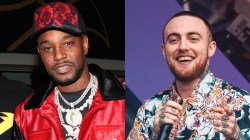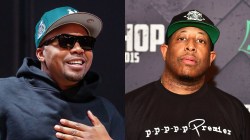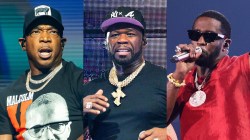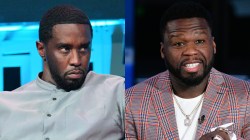The rapper and producer relationship is better built on trust, friendship, respect and ambition. It’s nearly a sacred union that’s worked for Eric B & Rakim, Snoop & Dre, Missy & Timbaland and Drake & 40 among others. One duo reaching their full potential this year was Yelawolf and WLPWR on the Shady Records artist’s sophomore album Love Story. The album at times almost felt like an accumulation of the South’s musical history from two creative viewpoints. Yela’s rock aesthetic reinvention blended perfectly with WLPWR’s head nodding bounce. While the future narrative of Love Story will revolve around Catfish Billy’s new beginning, it could be said for the South Carolina native as well. The end results have benefited them both for a future that seems limitless at this point and time.
Talking to DX, WLPWR explains his musical transformation through his work with Yela on Love Story and how Eminem’s dramatics in production inspired him.
WLPWR Explains Context Of Yela’s Approach To “Love Story”
Producing Yelawolf’s “Till its Gone” – The Werks Documentary from WLPWR OmniMedia on Vimeo.
DX: It’s been a great several weeks for you and Yelawolf since the release of Love Story. What exactly did you contribute to the project’s conception of the soundscape?
WLPWR: I guess the best thing to say is that I’ve been working with Yela for about 15 years. I started dealing with him around 2000 or 2001. So really, almost every project that he’s released, I’ve had a lot to do with the basic sound of them. We kind-of have something that we have together. We treated Love Story the same way. He came in with a concept and we were in the studio for six months trying to find out where we wanted to take the project. Once we got it, we cut about 30 – 40 records and we ended up picking 14 before I left. Turns out, ten of those records ended up making the album. It turned out to be a great foundation and I was even blessed enough to get a couple of things out of it. It just felt good man.
DX: Radioactive was met with a disappointing response. I thought it was pretty good. How much did that change the approach thematically for Love Story.
WLPWR: Really, the only thing that changed man was; due to resentment Yela had about the process of making Radioactive, we just didn’t invite anybody in. We went back to our roots man. The same way we made the original Trunk Muzik, we approached Love Story the same way. Just us, no A&R telling us what to sound like, nobody bringing in a hook with someone already on it or no pre-produced records. It was just us producing organically. That was the only thing that was different. I’m like you, I liked Radioactive. One thing I wished we would have done differently would have been to put the major pop acts on the project like we intended to. What didn’t make Radioactive good to people was that Yela didn’t have the star power to go with some of the hooks. One of those records were suppose to have Pink on it, another was suppose to have Usher on it and another was suppose to have Carrie Underwood on it. We never got that done. It seemed like he was trying to do these pop records when all he was doing was rapping. One of those records that made the album had the person who did the original demo version on the hook. In hindsight, there are some things I wish were done different but it was honestly a good project.
DX: Love Story has a streamlined sound and is a lot more condensed on the feature end. Can you explain the process of finding a clear direction that really fit Yela?
WLPWR: We purposely didn’t want it to sound like Trunk Muzik. The goal was to expand that because he’s forever changing. Every time I would run into him, he was going in a new direction. I appreciated that because it sharpened all of our skills. I just think when we went in, we had this idea of meshing Johnny Cash and Outkast. We did that the best we could. Those are two great artist. We didn’t try to exactly copy the two but did enough to give a real energy to Love Story. It had a real funky dirty south drum programing side to it and then we brought in the live instrumentation to add the country flair. For the most part, we did have a direction we wanted to go in and we just worked on it until we were happy with it. Then, we started building from there. That record “Till It’s Gone” is the perfect example of sticking to it until it happens. From there, we were able to finish the rest of the album.
DX: Love Story’s production load is mainly split between you, Malay and Yela. How did each of you guy’s sounds work together within the album’s concept without having the disjunction problem that many felt were apparent in Radioactive?
WLPWR: The thing about Radioactive was that I don’t know how I ended up under the radar on that album but I produced nine on the deluxe version and seven on the original. If you read up on it, it doesn’t even mention me on the album. I’m in the credits but not the write-ups which is weird because I didn’t understand that. From what I understand, it was originally suppose to be me just working with Yela but overtime, there are still some politics involved. However, this time, he only took instructions from Eminem himself. In terms of Malay, he was just as integral to Yela’s early career as I was. He was the other guy that Yela was working with during that time we first met. He did the Arena Rap project with Yela which was incredible and the tracks he did with Malay on Love Story were representative of that particular era. Malay’s career has gone into directions as you know he helped produce Frank Ocean’s Channel Orange. I think it was a brilliant move to bring him in and involve him. Alongside being a dope musician, his relationship with Yela is just as genuine as mine. Thinking about it, Yela just brought friends together to make an album and just so happens to be that we’re all dope in our own right. That’s not easy because sometimes you can’t bring in your homies to do something because they may not always be qualified to do it.
WLPWR Describes Eminem’s Input In “Love Story”
DX: Within the process of creating the album, where did this place Eminem?
WLPWR: Honestly, we’re professionals at this. Me and Yela have been doing this together for 15-years. Cutting records and producing is something that we do really well. He’s an awesome writer and though he doesn’t get credit for it, he’s a dope producer. We collaborate really well. I don’t have anyone who I work with that well. From my prior works with them I think Em and Shady Records assisted Yela with the direction. They trusted me on the production side of things when the only real accolade I had was with Wiz Khalifa. Outside of that, my discography was fairly average. I think that they really believed in what me and Yela were doing together. When we sent it to Eminem, we didn’t know what to expect but his response was overwhelming. He loved it and went with it. He really gave Yela the go-ahead. Especially when Yela was singing. We didn’t know what Em was going to say about that. He backed it and once he gave us the thumbs up, that allowed Yela to continue the vision. Like I said, we did those 14 records in the first sixth months and took over two years to complete the project.
DX: Eminem is the only feature on Love Story on the “Best Friends” track he co-produced with you. Did you take anything from him on the production side of things?
WLPWR: One of things I’ve taken from Eminem co-producing with me is that he’s really good at adding dramatics to a track. The small things that you don’t realize make all the difference. As he starts to rap, he’ll break the track down or build the track up. Even if that’s adding small things like strings or ambiance. They’re really effective. You really can’t add those things until after the vocals are done on those records because it’s hard to get a feel for what the rapper is doing while you’re recording. There are four or five records that we’ve co-produced together by now and that’s amazing to me because I came up such a huge fan of him. I was practically a stan myself. To have this opportunity has been awesome. I only been in the studio with him one time because well, he’s Eminem. It’s hard to get him in the room with his busy schedule. For the most part, I’m just watching and learning. Whatever he adds to a track, they give me an opportunity to approve it but I just let him do whatever. How exactly do you challenge someone who’s sold 40 or 50 million records? I just appreciate the honor of being able to work with him. When I got the verse back, I was like Oh My God this is great. I’m just happy because I etched myself into Hip Hop history.
DX: What changed in his approach with this track in comparison to the “Throw It Up” track with Gangsta Boo from Radioactive?
WLPWR: “Throw It Up” was me, Yela and Gangsta Boo in a room with each other. It just happened. It started off with that piano and Gangsta Boo doing that crazy ass hook. Then we were like alright, we got this. When we finished, we approached Eminem with it. It’s the same process. Yela and me get into the studio to work on a record and then we finish. When we finished “Best Friend,” then we approached Em with it because Yela thought it was perfect for him.
WLPWR Details History With Yelawolf
DX: There’s a complete change sonically in Love Story compared to his previous releases. However, there are still roots to his musical past including tracks like “Box Chevy V.” It evolved with both of you guys. Was it difficult matching the project’s theme with a track that has so much history to Yela?
WLPWR: I think “Box Chevy” is Yela’s anchor. Everytime he does something, that’s the one thing he wants to keep. He wants people to understand his country roots and his love for Chevys. I remember when we were coming up and Yela saved for a long time to buy a beat-up old Box Chevy. At the time, I couldn’t understand it for the love for the car. I was like you buy this beat-up old car, I don’t want a Chevy, I want a Mercedes. To him, a Box Chevy is a Mercedes. I appreciate his value for it because it goes to show his humble approach toward life. Like he’s cool with a Box Chevy. I think it’s his reminder of it. I don’t know that for a fact because I can’t speak for him but every time we do a “Box Chevy” track, it’s the most rooted on the project. What’s dope about the series is that wherever he goes musically, he takes it with him. Like you said, the series evolves. I just think that’s really dope. If we end up in outer space, that Chevy is going to be flying. I hope he continues it and hope that one day a series project comes out with all of them on it. It’s my favorite, it’s a fan favorite and it’s a track that continues to lock in the original fans to this day. I hope he sticks with it.
DX: From your perspective, where did Love Story began and did the end result lead to the initial concept?
WLPWR: Yeah, Love Story really began with Yela moving back to Nashville so he could get back in touch with his roots. We did Trunk Muzik Returns and that project ended with “Tennessee Love” which you know made the album. That was the record where we started to mesh live guitars along with the 808s. It just felt good and that’s when we decided we were going to do more of that from then on. That was really the beginning of Love Story. He had a concept that I wasn’t even 100 percent clear of at first. I didn’t know what Love Story was about as far as the definition was concerned. He had just proposed to his fiance so I was hoping he wasn’t actually going to do a love album. I trusted it with him and we most certainly just made a dope project. Love Story was basically a journey about his love for music and it turned out to be dope.
DX: How did the making of Love Story change your approach to making music from here on?
WLPWR: Basically for years, I was producing in a box. Drum machines, Logic and stuff like that. I’m a musician but I never brought in guitar players and things like that. It broadened my horizons and how to make the music focused. To be honest, I was in a world to where I didn’t want to share publishing or split songs. As I got into the process, I realized it didn’t matter what share you had of a record as long as the record comes out really dope. If it does better, your share looks better than if you and one other person just did it together and the song didn’t do so well. I learned a lot about it from the business end. From the creative end, I learned that this is the way to set yourself apart from other people. I always wanted to do it, I just didn’t have the resources to do it. I came up watching Jim Jonsin when I first started getting into this stuff. Jim Jonsin use to travel with his guitar player. I use to wonder why he did it and now I know. It really opened me up and got me to a point where I really don’t want to do anything else without live instrumentation there.
DX: Both you and Yela built a camaraderie with each other for the past 15 years, where does that stem from?
WLPWR: I met Yela around 2000, 2001 in New York. I had moved up there to sign on with a production company through Sylvia Robinson who owned Sugar Hill Records. I went up there working as a producer and Yela was coming from Alabama trying to get on as a rapper. Anyway, we met at the studio in the lobby. Within the first hour of meeting each other, we were in the studio cutting records. A lot of it had to come from the fact that we both came from the South. We just meshed and become friends. Over the years, we just stuck to it. There were times where we didn’t talk for a couple of years and then we’d come back together. We never had any beef or anything, it was just life getting in the way of things. Then we’d come together like nothing ever happened. It just continued that way and in 2007, Yela got signed to Columbia Records and he invited me to come work on his project for that album. I had two or three records make that album and then he got dropped. A few days later, we hit the studio and created Trunk Muzik. That’s when things started to take off. From there man, we’ve just been building and all types of things started to flourish.
DX: It’s been no secret of Yela’s ups and downs in regards to major labels. What was it like watching him go through that?
WLPWR: I think he’s the ultimate image of perseverance. I’ve tried and tried again with artists to recreate that level of success. It’s something in him that’s not in other people. It’s really a testament of who can really make it in the music business. Basically, anyone who has dealt with label issues like that and put out two albums or more, they are a special breed of people. There’s no luck involved, it’s just hard work. I remember us hustling CDs at college football games. We were at a South Carolina State game and there were 80,000 black people there and I had this white kid with me. That took a lot of courage. You can imagine before his record deal, to be a white boy putting out his type of music, it had to be tough. I can only imagine the stuff people were saying about him. You know how it goes. I have to give it to him. He never was a quitter. When I tell you, he’s seen some really hard times. I’ve witnessed him at his worst. I’ve worked with artists with half his problems and they’ve given up. My hat is off to him. He has a level of perseverance that’s unmatched.



![Method Man Admits He Didn't Like Drake's "Wu-Tang Forever": "I [Wasn't] Getting On That"](https://hiphopdx.com/wp-content/uploads/2025/12/method-man-drake-wu-tang-forever-remix.jpg?w=250)






I think this album is actually really dope. People just want to hate on Yelawolf but he talented.
One of the dopest interviews HHDX has ever put out
Great interview. Beautiful album
Really good interview! Nice producer and a sick album!
Could be that they quoted what he said in the interview…
So this producer is etched into Hip-Hop History with Eminem and Yelawolf but Love Story isn’t in your top 25 albums of the “year”…how does this make sense wtf
Haven’t listened to him since trunk muzik this interview has my interest peaked again. Good interview.
Sidenote
Ill proofread you guys shit for free man. Fucked up my enjoyment of reading…as I have to guess what sentences mean sometimes. Lol jk good interview though.
Damn i should have proofread my redundant ass post….by gee I’ve got it!!#